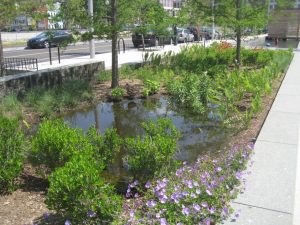
A rain garden. Photo: EPA
Wastewater and stormwater can be treated using a variety of methods, which are organized according to the degree to which they remove these contaminants.
Primary treatment uses mechanical methods that settle or float. Larger solids can be removed via screens, while smaller particles are skimmed or can be removed via a settling process. Only 50-60% of solids are removed at this stage of treatment.
Secondary treatment, in addition to using the methods above, uses biological processes to remove suspended solids and dissolved matter. Bacteria and chlorine are used to remove organic material and small particles. Ninety percent of solids are removed during this stage.
Tertiary treatment uses the methods above and filters the most harmful contaminants. Advanced treatments that fall under this category can disinfect wastewater from viruses and pathogens, making it safe to discharge near places like beaches. Nitrogen and phosphorus, which can harm aquatic ecosystems, can also be removed at this stage, along with persistent organic pollutants. Tertiary treatment methods can also remove over 99% of microplastics.
Following treatment, outflow from wastewater treatment plants, and any remaining contaminants it contains, flows directly into nearby streams, rivers and oceans. This is why advanced treatment is so important.
There are many ways to manage stormwater. Reducing the size of paved areas, using porous surface materials and building rain gardens all allow stormwater to flow into the ground, where it is naturally filtered. Conveyance controls, like storage tanks or special tunnels, can prevent stormwater from flooding wastewater treatment plants. Lastly, end-of-pipe controls like wet ponds can use landscaping and infrastructure to filter contaminants and slow the rate of stormwater flow, preventing flooding and erosion.

McCauley Point outfall, Victoria B.C.
McCauley Point outfall, Victoria BC. For generations, we have looked at sewage – wastewater and stormwater – simply as a waste product to be rid of. Too often, this waste is discharged into local rivers and oceans, without adequate treatment. The human waste, toxic chemicals and heavy metals contained in sewage end up in local waterways, endangering the health of both humans and marine life.
But is sewage really just a waste product, or is it a resource we’ve been overlooking?
Today, communities around the world are looking at sewage and organic waste differently, recovering resources such as heat, water and biofuels. With this approach to sewage management, communities are ending up with less pollution, and creating products, such as biofuels, that are helping them tackle climate change. Learn more about how sewage is being used as renewable energy resource here.

Iona Island Wastewater Treatment Plant. Photo: Metro Vancouver
Metro Vancouver once promised tertiary treatment at the Iona Island Wastewater Treatment Plant—the gold standard for protecting the Salish Sea. Now, that promise is slipping away. In a move framed as “cost-saving,” the region is backtracking from tertiary to a “just good enough” secondary treatment, a step that risks decades more of pollution pouring into one of B.C.’s most vital and inhabited marine ecosystems.
The Iona Island Wastewater Treatment Plant, serving roughly 850,000 people, currently treats it to a primary level only, allowing nutrients, microplastics, pharmaceuticals, heavy metals and more to pass through into our marine ecosystem. Metro Vancouver is under obligation to meet provincial and federal regulatory standards, and given the pressures from population growth, a major redesign can’t wait indefinitely. Beginning in 2024, planners have been exploring new configurations for the Iona upgrade that balance environmental goals with cost and ratepayer impacts. In July 2025, the Metro Vancouver Board held a special workshop to review an alternative phased approach. That alternative was formally adopted by the Board in October 2025, shifting the project to a two-phase delivery model.
Metro Vancouver frames this as a more “affordable, feasible” path, claiming it allows the region to deliver regulatory compliance while moderating rate impacts.
Critics warn that this approach could lock the region into years of underperformance, delaying the adoption of tertiary treatment—the only level capable of removing the most harmful pollutants that primary and even secondary systems cannot effectively manage.
Documents presented to the Board reveal that the long-term costs of deferral could be immense. Metro Vancouver staff estimate that completing the remaining work later could add up to $7.7 billion, bringing the total project cost to approximately $14.3 billion—far exceeding the original estimate.
Metro Vancouver’s decisions today will shape our coast for decades—let’s make sure they choose a future defined by clean water, not compromise.



